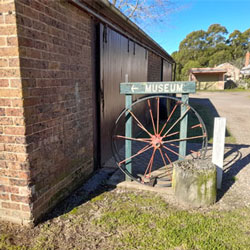Historical archaeology
Archaeology is the study of the human past through material remains. In Australia there are generally two major archaeological disciplines: Aboriginal archaeology and historical archaeology. Within these disciplines are a multitude of subset specialities.
Historical archaeology is broadly defined as archaeology focusing on societies that have left behind written records. In the context of the Sydney region, historical archaeology largely deals with the archaeological (physical) record following British colonisation in 1788.
Historical archaeology is often complemented and informed by documentary records. It can also contradict or disprove historical records. Within historical archaeology there are many subsets that deal with a variety of aspects of the human past including contact archaeology, being the archaeology illustrating contact between Aboriginal people and groups of people who arrived after colonisation.
Sites and places defined as being historical archaeological items are classed differently from those listed as landscape or built heritage in that they usually comprise archaeological remains (deposits, artefacts, objects, or material evidence) principally present underground (often not visible on the ground surface).
It is important to note that there can be overlap between categories.
For a further definition on Archaeological sites and relics, refer to: Assessing Significance for Historical Archaeological Sites and 'Relics' | NSW Environment and Heritage.
Historical Archaeology in Hornsby Shire
Hornsby Shire contains rich archaeological resources resulting from historical occupation and use, varied forms of settlement and exploitation within the region since 1788.
The early nineteenth century sites are connected to early access routes through the shire, alongside the Hawkesbury River and around the Shires its margins. Potential archaeological sites associated with these early lines of communication include hut and farmstead sites. Along the Hawkesbury, farm sites were often supplemented by landings, jetties, tide mills, and later shipbuilding establishments.
A second-phase was the establishment of the Great Northern Road in the 1820s, that saw road access between Sydney and Parramatta with the Hawkesbury crossing at Wisemans Ferry. This opened-up land for occupation that was not directly tied to the Hawkesbury. Terrain and marginal soils resulted in the concentration of grants in the southwest of the Shire and along alluvial river flats. Archaeological remains that may be associated with this phase of occupation include orcharding, road construction and later industrial activities.
The construction of the railway to Hornsby, and later across the Hawkesbury resulted in a further phase of development that saw the establishment and expansion of townships that later emerged as suburbs within the Shire.
Archaeological evidence associated with the late nineteenth and early twentieth centuries includes residential, commercial, and industrial sites.
To find out if a particular property is listed as an archaeological site refer to:
- Schedule 5 within the Hornsby Local Environmental Plan 2013 – NSW Legislation
- Council’s online Property Enquiry
- Council’s online Mapping System
For further information on an items historical archaeological significance, refer to Council’s online Heritage register.
Many items may have an individual listing or dual listing with a built or landscape heritage item.
Management of historical archaeological sites and relics
Hornsby Shire Council completed its first Archaeological heritage study under the 1993 Hornsby Shire Heritage Study. This has been the leading document to guide and promote the conservation and management practices of historical archaeology within Hornsby Shire for the past 25 years.
A new and updated Archaeological Heritage Study is currently being prepared under the Comprehensive Heritage Study.
Refer to Part 9 of the Hornsby Development Control Plan for general development guidelines to undertake work on land listed as an archaeological site
Refer to Heritage NSW to apply for an approval for works or activities that may impact archaeological relics or check if your proposal meets criteria for an excavation permit exception.
Renovating a Home
Buying and Selling

Celebrating our heritage through interpretation

Have your say on Hornsby Shire's heritage
Hornsby Shire Council values feedback from the community on what local residents regard as their local heritage.







